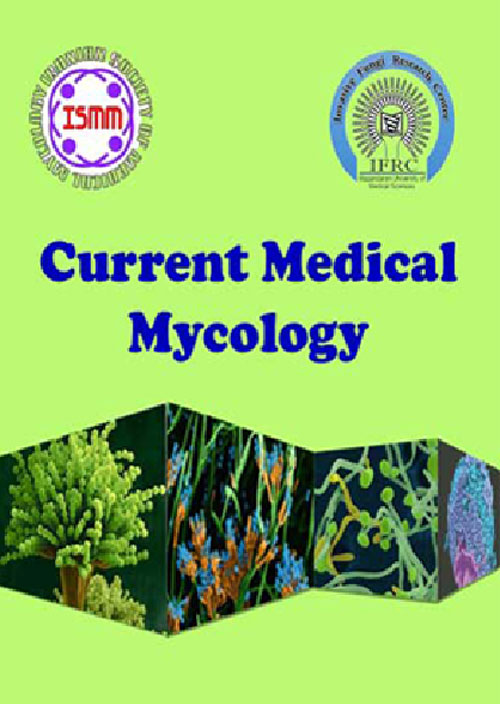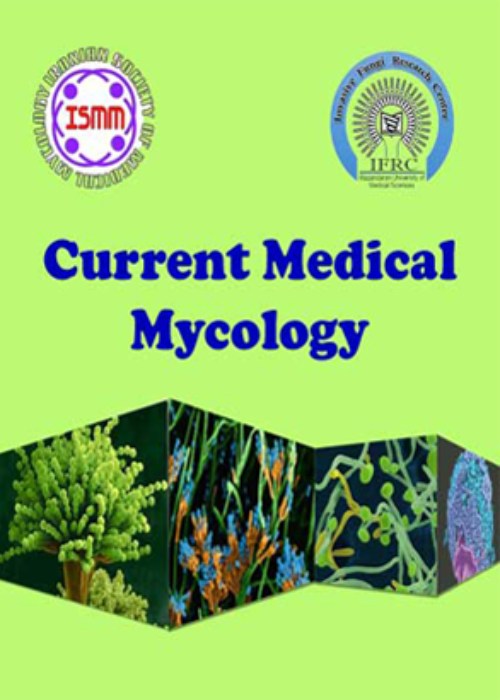فهرست مطالب

Current Medical Mycology
Volume:7 Issue: 4, Dec 2021
- تاریخ انتشار: 1401/02/05
- تعداد عناوین: 8
-
-
Pages 1-5Background and Purpose
Due to the fact that fungal species such as Aspergillus flavus and Aspergillus parasiticus produce carcinogenic and mutagenic aflatoxins and have the potential to produce fungal secondary metabolites, fungal contamination should be avoided. This study was conducted using the HPLC method and was aimed at examining the fungal contamination of Isfahan hazelnuts in order to identify the presence of Aflatoxins.
Materials and MethodsOne hundred samples of hazelnuts were randomly collected from supermarkets in Isfahan. The samples were then cultured on Sabouraud dextrose agar (SDA) media and analyzed to determine fungal contaminations. The aflatoxin analysis was carried out using the HPLC method.
ResultsIt was discovered that nine genera of fungi, namely Aspergillus, Penicillium , Rhizopus, Ulocladium, Alternaria, Drechselera, Trichothecium, Scopulariopsis, and Mucor were identified in 78% of the samples. Samples contaminated with Aspergillus flavus (22 samples) were studied to determine the presence of aflatoxin. The results showed that 16 (72.72%) of the samples were contaminated with AFB1, AFB2 and AFG2 and the mean concentrations were 0.926, 0.563 and 0.155ng/g, respectively.
ConclusionsSome parameters that affect mycotoxin production are temperature, food substrate, strain of the mold and other environmental factors. Due to the toxigenic quality of some of these fungi and their hazard to human health, it is crucial that fungal contamination and aflatoxin identification tests are carried out before certain products are made available to the mass market.
Keywords: Nuts, HPLC, Aflatoxin, Iran -
Pages 6-11Background and Purpose
Vulvovaginal candidiasis (VVC) is an opportunisticinfection due to Candida species, one of the most common genital tract diseases among reproductive-age women. The present study aimed to investigate the prevalence of VVC among non-pregnant women and identify the epidemiology of the involved Candida species with the evaluation of antifungal susceptibilities.
Materials and MethodsMatrix-assisted laser desorption/ionization time-of-flight mass spectrometry (MALDI-TOF MS) was performed to identify Candida species isolated from the genital tract of 350 non-pregnant women. Moreover, antifungal susceptibility testing was performed according to the Clinical and Laboratory Standards Institute broth microdilution method guidelines (M27-A3 and M27-S4).
ResultsVaginal swab cultures of 119 (34%) women yielded Candida species. Candidaalbicans was the most frequently isolated species (68%), followed by Candida glabrata(19.2%). Voriconazole was the most active drug against all tested isolates showing anMIC50/MIC90 corresponding to 0.016/0.25 µg/mL, followed by posaconazole (0.031/1µg/mL). Overall, resistance rates to fluconazole, itraconazole, and voriconazole were2.4%, 4.8% and, 0.8% respectively. However, posaconazole showed potent in vitro activity against all tested isolates.
ConclusionResults of the current study showed that for the effectual therapeuticoutcome of candidiasis, accurate identification of species, appropriate source control,suitable antifungal regimens, and improved antifungal stewardship are highly recommended for the management and treatment of infection with Candida, like VVC.
Keywords: Antifungal susceptibility, Candida species, MALDI-TOF, Vulvovaginal candidiasis -
Pages 12-18Background and Purpose
The pandemic of COVID-19 has caused a worldwide healthcrisis. Candidemia is a potentially lethal condition that has not yet been enough discussed in patients with COVID‐ 19. The current study aimed to investigate the prevalence of candidemia among Iranian COVID‐ 19 patients and characterize itscausative agents and the antifungal susceptibility pattern.
Materials and MethodsThe present cross-sectional survey was carried out fromMarch 2020 to March 2021 at Imam Khomeini Hospital, Tehran, Iran. Bloodspecimens were obtained from patients with confirmed coronavirus infection who alsohad criteria for candidemia and were examined for any Candida species by conventional and molecular techniques. Susceptibility of isolates to amphotericin B,voriconazole, itraconazole, fluconazole, caspofungin, and 5-flucytosine was testedusing the CLSI broth dilution technique.
ResultsIn total, 153 patients with COVID-19 were included and candidemia wasconfirmed in 12 (7.8 %) of them. The majority of patients were ≥ 50 years of age (n=9)and female (n=8). Moreover, 6 out of the 12 patients were diabetic. The presence ofcentral venous catheters, broad-spectrum antibiotic therapy, ICU admission, andmechanical ventilation was observed in all patients. The C. albicans (n=7, 58.3 %) andC. dubliniensis (n=2, 16.7%) were the most common isolated species. Amphotericin Band 5-flucytosine were the most active drugs. Despite antifungal treatment, 4 out of 12patients (33.3 %) died.
ConclusionDue to the high mortality, the early diagnosis and proper treatment ofcandidemia are essential requirements for optimal clinical outcomes in COVID-19 patients.
Keywords: Candidemia, C. albicans, C. dubliniensis, COVID-19, Iran -
Pages 19-27Background and Purpose
The healthcare system in India collapsed during the secondwave of the COVID-19 pandemic. A fungal epidemic was announced amid the pandemic with several cases of COVID-associated mucormycosis and pulmonary aspergillosis being reported. However, there is limited data regarding mixed fungal infections in COVID-19 patients. Therefore, we present a series of ten consecutive COVID-19 patients with mixed invasive fungal infections (MIFIs).
Materials and MethodsAmong COVID-19 patients hospitalized in May 2021 at atertiary care center in North India, 10 cases of microbiologically confirmed COVID-19-associated mucormycosis-aspergillosis (CAMA) were evaluated.
ResultsAll patients had diabetes and the majority of them were infected with severeCOVID-19 pneumonia (6/10, 60%) either on admission or in the past month while twowere each of moderate (20%) and mild (20%) categories of COVID-19; and were treatedwith steroid and cocktail therapy. The patients were managed with amphotericin-B along with surgical intervention. In total, 70% of all CAMA patients (Rhizopus arrhizus with Aspergillus flavus in seven and Aspergillus fumigatus complex in three patients)survived.
ConclusionThe study findings reflected the critical importance of a high index ofclinical suspicion and accurate microbiological diagnosis in managing invasive dualmolds and better understanding of the risk and progression of MIFIs among COVID-19patients. Careful scrutiny and identification of MIFIs play a key role in theimplementation of effective management strategies.
Keywords: Aspergillosis, Coronavirus disease, invasive fungal disease, Mucormycosis -
Pages 28-33Background and Purpose
This study aimed to assess the effect of Allium cepa ethanolic extract (ACE) loaded polyacrylonitrile (PAN) and polyvinyl pyrrolidone (PVP) nanofibers on Candida albicans (C. albicans) CDR1 and CDR2 genes expression.
Materials and MethodsThe minimum inhibitory concentrations (MICs) of ACE against C. albicans ATCC 10231 and clinical fluconazole (FLC)-resistant C. albicans PFCC 93-902 were determined using the Clinical and Laboratory Standards Institute (CLSI) protocol (M27-Ed4) at a concentration range of 45.3-5800 µg/ml. The nanofibers containing ACE (60 wt%) were fabricated using the electrospinning technique. The expression of the CDR1 and CDR2 genes was studied in the fungus exposed to ACE loaded nanofibers and 0.5×MIC concentration of FLC using the real-time polymerase chain reaction.
ResultsMIC50 and MIC90 of ACE against FLC-resistant C. albicans were 725 and 1450/mL, respectively. The expression of CDR1 (4.5-fold) and CDR2 (6.3-fold) were down-regulated after the exposure of FLC-resistant C. albicans to ACE-loaded nanofibers (P<0.05). Furthermore, the expression of CDR1 (2.8-fold) and CDR2 (3.2- fold) were up-regulated in FLC-treated C. albicans (P<0.05).
ConclusionThe results revealed that nanofibers containing ACE interact with drug resistant genes expressed in C. albicans. Further studies are recommended to investigate the mode of action and other biological activities of ACE-loaded nanofibers against C. albicans and other pathogenic fungi
Keywords: Allium cepa, candida albicans, CDR1, CDR2, Gene expression, PAN, PVP nanofibers -
Pages 34-37Background and Purpose
Histoplasma capsulatum is the cause of a prevalent fungal disease in certain regions in the United States of America, like Ohio and the Mississippi River. Its clinical manifestations range from asymptomatic to life-threatening diseases,according to the immune system. A definitive diagnosis is made by biopsy.
Case report:
Two middle-aged brothers presented with a nine-day history of severe progressive dyspnea. Both were living in Cincinnati, Ohio, and encountered bird droppings 7 days prior to symptoms while working on a roofing project. It should be mentioned that they were not wearing masks. After extensive testing, they were diagnosed with acute pulmonary histoplasmosis. Both were successfully treated with azole-derivative fungal therapy.
ConclusionThis is the first case of histoplasmosis acquired through occupational exposure related to roofing and is unique given the two patients were siblings
Keywords: Fungal, Histoplasmosis, Ohio, Spores, United States -
Pages 38-42Background and Purpose
Scedosporium spp. is a saprophytic fungus that may cause invasive pulmonary infection due to the aspiration of contaminated water in both immunosuppressed and immunocompetent hosts.
Case report:
Herein, we report a fatal case of pulmonary infection caused by Scedosporium species associated with a car crash and near-drowning in a sewage canal.Scedosporium aurantiacum isolated from bronchoalveolar lavage was identified by PCR-sequencing of β-tubulin genes. The minimum inhibitory concentration values for amphotericin B, itraconazole, posaconazole, isavuconazole were >16 µg/ml, and >8 µg/ml for anidulafungin, micafungin, and caspofungin. Voriconazole was found to be the most active agent with a MIC of 1 µg/ml.
ConclusionThis report, as the first case of pulmonary scedosporiosis after near-drowningin Iran, highlights the importance of high suspicion in near-drowning victims, promptidentification of Scedosporium spp., and early initiation of appropriate antifungal therapy.
Keywords: Antifungal susceptibility test, Amphotericin B, invasive pulmonary infection, near-drowning, Scedosporium aurantiacum, voriconazole -
Pages 43-48Background and Purpose
Although Aspergillus fumigatus and Aspergillus flavus are more commonly implicated with ocular infections; there are some saprophytic species, such as Aspergillus nidulans (A. nidulans) which may occasionally lead to serious ocular infections. There is a paucity of data on ocular infections caused by A. nidulans. We report a case series of three ophthalmic infections caused by A. nidulans from a tertiary care eye center in North India.
Case report:
Three cases of ophthalmic infections, including two cases of keratitis and one case of recurrent endophthalmitis caused by A. nidulans were diagnosed at the ocular microbiology section of a tertiary eye care center. One case of keratitis had a history of ophthalmic surgery and underlying diabetes mellitus. The case of recurrent endophthalmitis had undergone cataract surgery in the recent past. Diminution of vision was the most common presenting feature in all three cases. The microbiological diagnosis was made by conventional microscopy and culture techniques.
ConclusionThis case series illustrates the potential of uncommon fungal pathogens, such as A. nidulans to cause devastating ocular infections and has an emphasis on the importance of timely microbiological diagnosis in the management of such cases.
Keywords: Antifungal susceptibility, Aspergillus nidulans, ophthalmic infections


